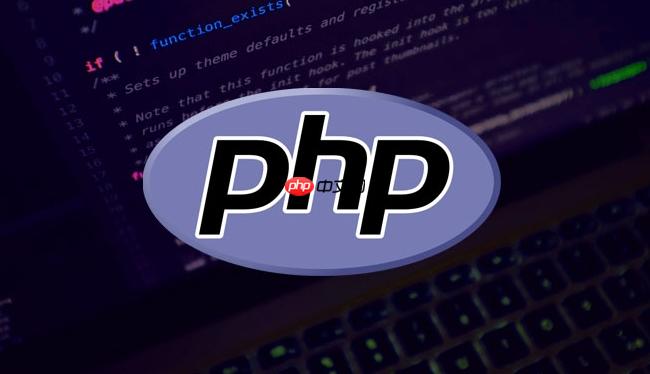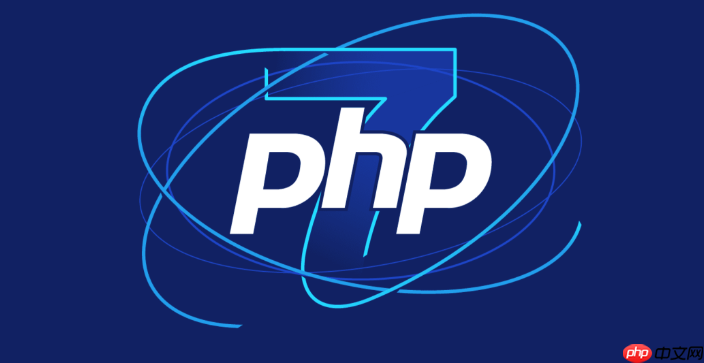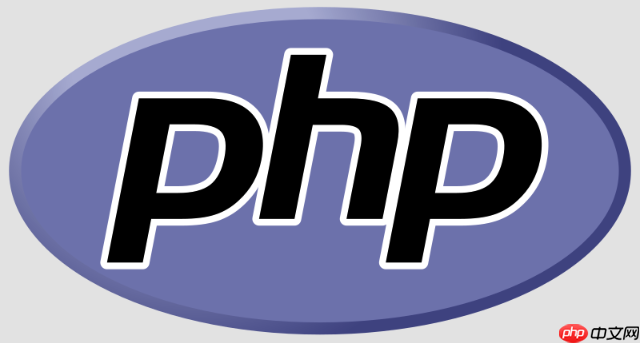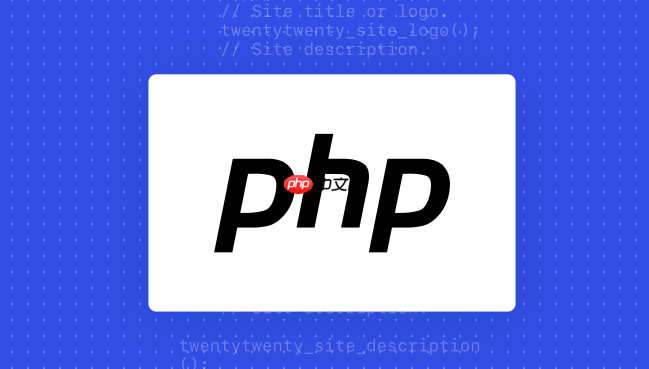 Backend Development
Backend Development
 PHP Tutorial
PHP Tutorial
 How to use PHP combined with AI to analyze video content PHP intelligent video tag generation
How to use PHP combined with AI to analyze video content PHP intelligent video tag generation
How to use PHP combined with AI to analyze video content PHP intelligent video tag generation
Jul 25, 2025 pm 06:15 PMThe core idea of PHP combining AI for video content analysis is to let PHP serve as the backend "glue", first upload video to cloud storage, and then call AI services (such as Google Cloud Video AI, etc.) for asynchronous analysis; 2. PHP parses the JSON results, extract information such as characters, objects, scenes, voice, etc. to generate intelligent tags and store them in the database; 3. The advantage is to use PHP's mature web ecosystem to quickly integrate AI capabilities, which is suitable for projects with existing PHP systems to efficiently implement; 4. Common challenges include large file processing (directly passing through cloud storage with pre-signed URLs), asynchronous tasks (introducing message queues), cost control (on-demand analysis and budget monitoring) and result optimization (label standardization); 5. Smart tags significantly improve video retrieval efficiency, implement fine classification, empower recommendation systems and assist content review, and ultimately convert unstructured video into manageable structured data, ending with complete sentences.

Using PHP to combine AI for video content analysis, especially smart video tag generation, the core idea is to use PHP as the backend "glue" to connect your video storage and external AI services. PHP itself does not directly run complex AI models. Its advantages lie in handling HTTP requests, file uploads, database interactions, and calling various APIs. So, after you upload a video, PHP will be responsible for sending the video (or its link) to a dedicated AI service (such as Google Cloud Video AI, AWS Rekognition, Azure Video Indexer, and even an AI inference service built in Python), and then wait for these services to return the analysis results. These results are usually structured JSON data, which PHP then parses, extracts key information from the video content (such as identified characters, objects, scenes, activities, voice to text, emotional tone, etc.), and ultimately converts them into available smart tags and stores them in the database for subsequent retrieval and management.

Solution
To implement PHP combined with AI for video content analysis and intelligent label generation, this usually involves several key steps and the collaboration of the technology stack:
First of all, video upload and storage are the basics. Users upload video files through the PHP-driven front-end interface. After receiving files in the PHP backend, the best practice is to store them to cloud storage services (such as AWS S3, Google Cloud Storage, or Azure Blob Storage) rather than directly on-site to the server. This not only solves the problems of large file storage and bandwidth, but also facilitates subsequent AI services to directly pull videos from the cloud for analysis.

Next, there is the core AI service call. Once the video upload is completed and it is retrieved to its storage path (URL), PHP can send API requests to the selected AI video analytics service via an HTTP client such as Guzzle or PHP's built-in curl . This request will include the URL of the video, the type of analysis you want to perform (such as object recognition, scene analysis, voice to text, face recognition, etc.), and the necessary authentication information (API Key or OAuth Token). Since video analysis is often a time-consuming process, AI services often adopt an asynchronous processing mode. This means that after PHP sends the request, it will not get the final result immediately, but instead get an operation ID. PHP needs to regularly query the status of this operation ID, or more elegantly, after the analysis of the AI service will be completed, the URL specified by PHP will be called back through the Webhook to inform the analysis that it has been completed and the result link is provided.
This is usually a complex JSON object when an AI service returns the analysis results. The task of PHP is to parse this JSON and extract useful information from it. For example, if the AI recognizes that the video contains tags such as "cat", "dog", "park", and activities such as "running", "playing", or extracts keywords such as "product conference" and "user feedback" from the voice. PHP will transform these original AI insights into concise and standardized smart tags based on preset rules or algorithms. These tags can include physical tags (such as “product name”, “brand”), subject tags (such as “news”, “sports”), emotional tags (such as “positive”, “negative”), etc.

Finally, these generated smart tags will be stored in the database (such as MySQL, PostgreSQL) and associated with the corresponding video records. In this way, when the user searches for "cat" or "product conference", the relevant videos can be quickly retrieved. At the same time, you can also use these tags to recommend content, classify videos, and even review content. Throughout the process, PHP plays an efficient coordinator role, which does not directly perform complex calculations, but cleverly utilizes external professional AI capabilities.
Why choose PHP to integrate AI video analysis?
To be honest, PHP is not a mainstream language in the AI field. You won't use it to train complex deep learning models, nor will you use it to directly run TensorFlow or PyTorch inference. But when it comes to "integrated" AI video analysis, the advantages of PHP are revealed, especially in an existing web ecosystem.
First, for many companies and developers, PHP is the foundation of their web applications. If your entire content management system, user interface, and backend logic are built with Laravel, Symfony, or WordPress, introducing a Python microservice specifically to handle AI tasks is technically feasible, but it may add unnecessary complexity to deployment, maintenance, and team skills stacks. As a backend language, PHP has an extremely mature and efficient ecosystem in handling HTTP requests, file uploads, and database interactions. This means you can seamlessly integrate the steps of video upload process, AI API calls, result parsing and database storage into your existing PHP application very smoothly.
Secondly, PHP is very efficient in development. There are a large number of libraries and frameworks that can help you build features quickly. For example, the Guzzle HTTP client makes calling external APIs extremely simple, and processing JSON data is even more of a strong point of PHP. For many business scenarios, what we need is not to build an AI model from scratch, but to leverage off-the-shelf, powerful cloud AI services. PHP performs well in this role as a "glue layer". It can efficiently coordinate data flow, send videos out, take the results back, and store them well. This is its main battlefield.
Of course, it also has limitations. If your core requirement is to conduct large-scale, real-time custom AI model inference, or to require fine control and optimization of the AI model itself, then languages such as Python or Java may be more suitable. However, for most scenarios where "using AI to empower existing businesses", the practicality and convenience of PHP, especially in terms of web service integration, cannot be ignored. It is the "old guy" who can quickly run your AI capabilities and closely integrate with existing business logic.
Common challenges and solutions for PHP combining AI for video content analysis
In actual operation, using PHP to bridge AI video analysis will indeed encounter some minor troubles, which is not as direct as writing a simple form to submit. But don't worry, these challenges have mature solutions.
A more obvious problem is the processing of large files . Video files are usually large, and upload them directly to the server through PHP and then forwarded, which may encounter memory limits, upload timeouts, or bandwidth bottlenecks. My experience is that the best way is to have the client (browser) upload the video directly to cloud storage services (such as AWS S3, Azure Blob Storage) instead of going through the PHP server first. You can generate a pre-signed URL (Pre-signed URL) through PHP, so that the client can upload it directly to this URL. In this way, PHP only needs to record the address of the video on the cloud storage and then pass this address to the AI service, which greatly reduces the pressure on the server.
Another challenge is asynchronous processing . AI video analysis is a time-consuming job, ranging from a few seconds to a few minutes or even longer. PHP is executed synchronously by default, and you cannot let users wait for the page to refresh. Here we need to introduce Message Queue and Background Jobs . When PHP receives the notification that the video upload is completed, it does not immediately call the AI service, but throws the task of "calling the AI service to analyze this video" into the message queue (such as Redis or RabbitMQ). Then, you start a standalone PHP process (or use components like Laravel Horizon or Symfony Messenger) as a consumer, which will take the task from the queue and then call the AI service. After the AI service analysis is completed, it will call back your PHP application through the Webhook, and then PHP updates the video tag and status. This mode decouples front-end response and back-end time-consuming operation, improving user experience.
Cost management is also a practical problem. AI services are usually charged by usage, and video analytics are especially not cheap. If you are not careful, your bill may make your heart beat faster. Solutions include: First, conduct effectiveness checks before calling the API to avoid repeated analysis of the same video; second, consider on-demand analysis , such as triggering analysis only after the user explicit requirements or the video has been viewed for a certain number of times; finally, monitor API usage , set budget reminders, and regularly review the different analysis levels and prices provided by AI services, and choose the one that best suits your needs.
In addition, the error handling and retry mechanisms must also be considered thoroughly. Network fluctuations, API current limits, and services are temporarily unavailable. Your PHP code needs to have a robust try-catch block, and for retryable errors (such as 5xx server errors or 429 current limit), exponential backoff retry logic should be implemented instead of simply retrying immediately. This can effectively improve the stability and fault tolerance of the system.
Finally, interpretation and optimization of AI results . The tags given by AI services may be very detailed and even a little redundant. You need to write logic to filter, merge, and standardize these tags to make them more in line with your business needs. For example, AI may identify "cats", "kittens", and "persian cats", and you may just want to be unified as "felines" or "pets". This requires some logic for data cleaning and mapping to ensure that the final generated tags are meaningful and consistent.
How to improve content management and retrieval efficiency with smart video tags?
Smart video tags, this thing sounds a bit technical, but the actual value it brings, especially the improvement of content management and retrieval efficiency, is real. In my opinion, it is like installing a smart "index brain" on video content.
First of all, the most direct benefit is that it greatly improves the searchability of videos . Think about it, in the past, we wanted to find a video, and we could only rely on title, description or manual keywords. But if the video content itself is not described in detail, or the keywords are inaccurate, it is simply a needle in a haystack. Intelligent tags automatically identify people, objects, scenes, activities, and even voice content in videos through AI, generating a large number of precise tags. For example, in a video about "cooking", in addition to the label of "cooking", AI may also identify "kitchen", "knife", "vegetables", and "recipes", and even extract specific information such as "scrambled eggs with tomatoes" and "how to cut onions" from the voice. When users search, input any relevant word and can quickly locate the target video, which is simply revolutionary for platforms with a large amount of video content.
Secondly, it can achieve more refined content classification and organization . The traditional video classification may only have major categories such as "entertainment", "education", and "news". But with smart tags, you can classify more detailedly based on specific elements appearing in the video (such as "outdoor sports", "city scenery", "children's content". This not only helps content managers organize and archive videos more efficiently, but also provides users with more dimensions of content browsing and discovery paths. For example, users can filter out all outdoor sports videos containing "dogs" or documentaries of all "historical figures".
Furthermore, smart tags are crucial for content recommendations and personalized experiences . When the system knows that users like to watch videos with "cat" and "funny" tags, it can recommend similar content more accurately, improving user stickiness and satisfaction. This is not only based on user viewing history, but also on the in-depth understanding of the video content itself. For advertising, this can also achieve more accurate content-related advertising delivery and improve ad click-through rate and conversion rate.
In addition, smart tags can also play a role in content auditing and compliance . AI can help identify whether sensitive content (such as violence, pornography, hate speech) exists in videos, or whether it contains a specific brand of logo (for copyright or brand cooperation management). This greatly reduces the burden of manual review and improves audit efficiency and accuracy.
All in all, smart video tags fundamentally change the way we interact with video content. It converts originally unstructured video data into searchable, manageable and utilizeable structured information, providing users with a smoother discovery experience, and bringing unprecedented efficiency improvement and commercial value to content operators.
The above is the detailed content of How to use PHP combined with AI to analyze video content PHP intelligent video tag generation. For more information, please follow other related articles on the PHP Chinese website!

Hot AI Tools

Undress AI Tool
Undress images for free

Undresser.AI Undress
AI-powered app for creating realistic nude photos

AI Clothes Remover
Online AI tool for removing clothes from photos.

Clothoff.io
AI clothes remover

Video Face Swap
Swap faces in any video effortlessly with our completely free AI face swap tool!

Hot Article

Hot Tools

Notepad++7.3.1
Easy-to-use and free code editor

SublimeText3 Chinese version
Chinese version, very easy to use

Zend Studio 13.0.1
Powerful PHP integrated development environment

Dreamweaver CS6
Visual web development tools

SublimeText3 Mac version
God-level code editing software (SublimeText3)

Hot Topics
 VSCode settings.json location
Aug 01, 2025 am 06:12 AM
VSCode settings.json location
Aug 01, 2025 am 06:12 AM
The settings.json file is located in the user-level or workspace-level path and is used to customize VSCode settings. 1. User-level path: Windows is C:\Users\\AppData\Roaming\Code\User\settings.json, macOS is /Users//Library/ApplicationSupport/Code/User/settings.json, Linux is /home//.config/Code/User/settings.json; 2. Workspace-level path: .vscode/settings in the project root directory
 Understanding MVC: How Laravel Implements the Model-View-Controller Pattern
Aug 02, 2025 am 01:04 AM
Understanding MVC: How Laravel Implements the Model-View-Controller Pattern
Aug 02, 2025 am 01:04 AM
LaravelimplementstheMVCpatternbyusingModelsfordatamanagement,Controllersforbusinesslogic,andViewsforpresentation.1)ModelsinLaravelarepowerfulORMshandlingdataandrelationships.2)ControllersmanagetheflowbetweenModelsandViews.3)ViewsuseBladetemplatingfor
 yandex web version entrance How to download Binance yandex safe download Binance
Aug 01, 2025 pm 06:27 PM
yandex web version entrance How to download Binance yandex safe download Binance
Aug 01, 2025 pm 06:27 PM
When using Yandex to find the official Binance channel, you must accurately locate the official website by searching for "Binance Official Website" or "Binance Official Website"; 2. After entering the official website, find the "Download" or "App" entrance in the header or footer, and follow the official guidelines to download or obtain the officially verified installation files through the app store; 3. Avoid clicking on advertisements or third-party links throughout the process, ensure that the domain name is correct and the link is trustworthy, so as to ensure the download security.
 Toncoin latest price trend app 24-hour TON coin k-line chart online analysis
Aug 01, 2025 pm 09:42 PM
Toncoin latest price trend app 24-hour TON coin k-line chart online analysis
Aug 01, 2025 pm 09:42 PM
Toncoin (TON) is a decentralized first-tier blockchain originally conceived by the Telegram team. It is known for its high performance, low cost and user-friendly features, and aims to provide an open network platform for billions of users around the world. Its native token TON is used in the network to pay transaction fees, pledge and participate in network governance.
 How to share data between multiple processes in Python?
Aug 02, 2025 pm 01:15 PM
How to share data between multiple processes in Python?
Aug 02, 2025 pm 01:15 PM
Use multiprocessing.Queue to safely pass data between multiple processes, suitable for scenarios of multiple producers and consumers; 2. Use multiprocessing.Pipe to achieve bidirectional high-speed communication between two processes, but only for two-point connections; 3. Use Value and Array to store simple data types in shared memory, and need to be used with Lock to avoid competition conditions; 4. Use Manager to share complex data structures such as lists and dictionaries, which are highly flexible but have low performance, and are suitable for scenarios with complex shared states; appropriate methods should be selected based on data size, performance requirements and complexity. Queue and Manager are most suitable for beginners.
 What is a weak reference in Python and when should you use it?
Aug 01, 2025 am 06:19 AM
What is a weak reference in Python and when should you use it?
Aug 01, 2025 am 06:19 AM
Weakreferencesexisttoallowreferencingobjectswithoutpreventingtheirgarbagecollection,helpingavoidmemoryleaksandcircularreferences.1.UseWeakKeyDictionaryorWeakValueDictionaryforcachesormappingstoletunusedobjectsbecollected.2.Useweakreferencesinchild-to
 Using PHP for Data Scraping and Web Automation
Aug 01, 2025 am 07:45 AM
Using PHP for Data Scraping and Web Automation
Aug 01, 2025 am 07:45 AM
UseGuzzleforrobustHTTPrequestswithheadersandtimeouts.2.ParseHTMLefficientlywithSymfonyDomCrawlerusingCSSselectors.3.HandleJavaScript-heavysitesbyintegratingPuppeteerviaPHPexec()torenderpages.4.Respectrobots.txt,adddelays,rotateuseragents,anduseproxie
 How to schedule tasks with the Laravel scheduler?
Aug 02, 2025 am 08:53 AM
How to schedule tasks with the Laravel scheduler?
Aug 02, 2025 am 08:53 AM
Laravel's scheduler centrally manages timing tasks by defining tasks in Kernel.php and using a single cron to execute schedule:run every minute. 1. Define tasks in the schedule method of app/Console/Kernel.php, such as $schedule->command('inspire')->daily(); 2. Add system cron: *cd/path-to-project&&phpartisanschedule:run>>/dev/null2>&1; 3. Common uses





